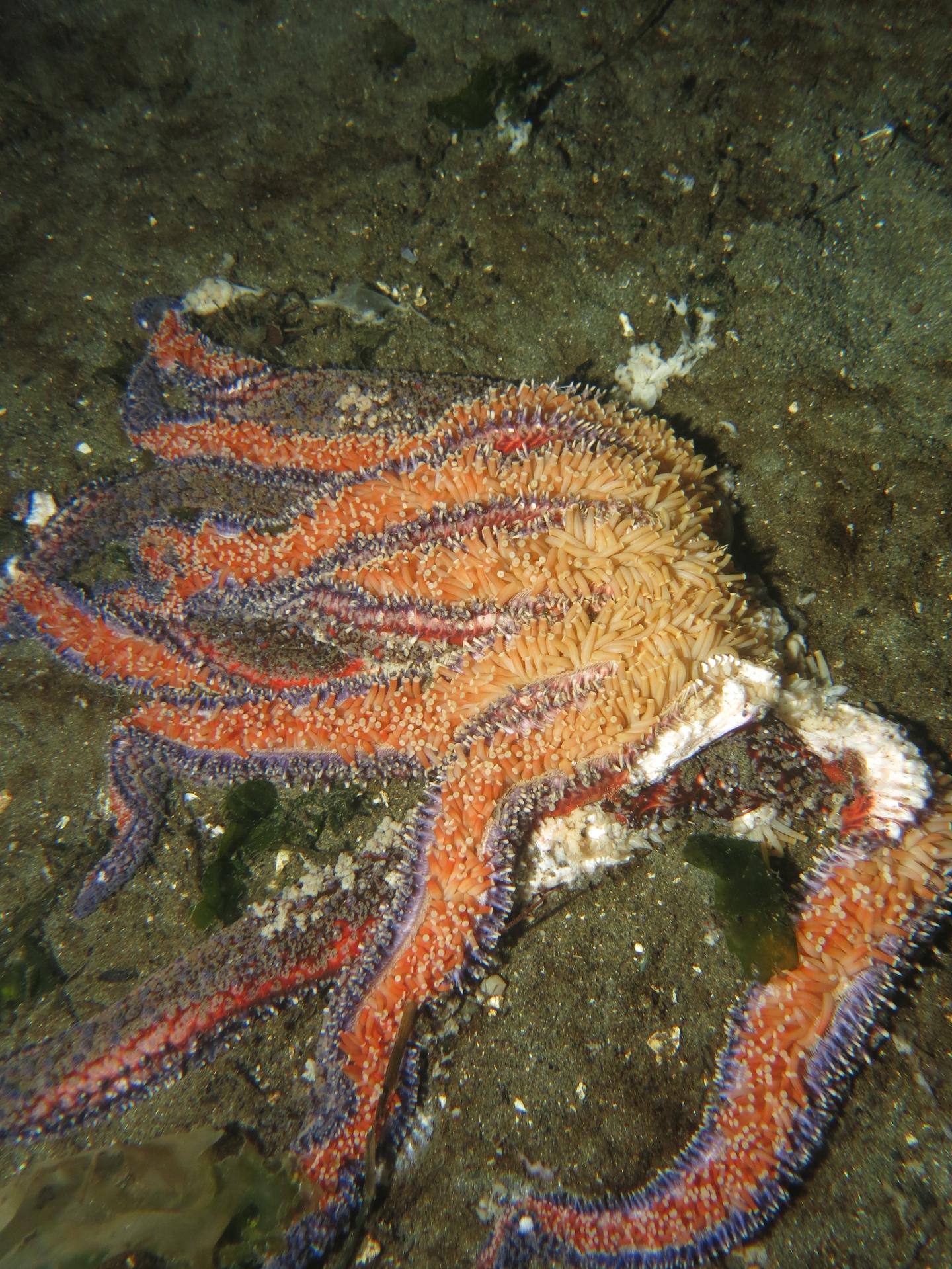Warmer Temperatures and Disease Decimated This West Coast Starfish in Two Years
The sunflower sea star, one of the largest starfish species in the world, has been practically wiped out along the west coast of North America, putting ecosystems at risk, according to a study published Wednesday in Science Advances.
Led by Drew Harvell, a Cornell University professor of ecology and evolutionary biology, the authors found that a recent outbreak of sea star wasting disease reduced the population by 80 to 100 percent across 3,000 kilometers of its territory.
Warmer ocean temperatures put these animals at a greater risk of infection, the team said.
"In the lower 48, there's no question that [the sunflower sea star] is endangered and imperiled in those waters," Harvell told Motherboard in a Skype call. "Although the disease has reached Alaska and there have been widespread mortalities there, we think at the very northern end of the range, they may be hanging on."
Harvell added that the sunflower sea star is endemic to its West Coast habitat. "If it does disappear from these shores, it is gone from the planet."
Sea star-wasting disease is a viral illness that causes starfish to develop lesions that decay tissue, resulting in bodily collapse and limbs that fall off and sometimes walk away. An outbreak that began in 2013 devastated over 20 starfish species, but Harvell's team focused on the sunflower sea star because its population losses hadn't yet been quantified. This is partly because the species lives in a more remote subtidal zone compared to the familiar tidal starfish that occupy accessible beach habitats.
Using records of fishing trawler bycatch and data from nearly 11,000 dives by trained citizen scientists, Harvell and her colleagues estimated the abundance of the sunflower sea star before and after the outbreak.
"The success of our study hinges on the fact that [the species] is so easy to identify," Harvell said. "The citizen diver database had beautiful data on the numbers of the sunflower sea star ten years before the outbreak so we can really document exactly the decline."
The results were staggering: Before the outbreak, divers normally counted two to 100 sunflower sea stars in their surveys from California to British Columbia. After 2014, 60 percent of divers reported only one sunflower sea star, or none at all. In offshore habitats, the sea stars were wiped out, suggesting they found no refuge from the disease in deeper waters.
 A sunflower sea star suffering from sea star wasting disease. Image: Ed Gullekson
A sunflower sea star suffering from sea star wasting disease. Image: Ed Gullekson The team also compared the number of sunflower sea stars in places with higher surface temperatures, which showed the sunflower sea star was more vulnerable to infection when waters were unusually warm. The link might be due to metabolic stress induced by heat, but more research needs to be done to flesh it out.
"The really vexing part of this outbreak is that the pathogen is not culturable so we can't do experiments with it," Harvell explained. "We can't test how the pathogen responds to temperatures separately from how the host animals respond to temperatures."
Read More:A Boom in Starfish Babies Is a Good Sign After the Chaos of Melting Disease
The sudden loss of this prolific predator is already disrupting ecosystems. Sunflower sea stars eat abalone and urchins, and those populations have exploded in some areas in the absence of the stars. With no predators checking their numbers, urchins overgraze on kelp beds, a habitat for many organisms, and create desolate "urchin barrens." This reduces biodiversity, and sometimes leads to urchins starving once the barrens can no longer sustain their large populations.
These wide-ranging problems prompted Harvell and her colleagues to raise the alarm about the species' dramatic decline and generate ideas to protect them from future outbreaks. She said it seemed like a "no-brainer" to start captive breeding programs, both for future reintroduction to the wild and to study the dynamics of sea star-wasting disease.
"It is really important to make the issue clear how rapidly disease outbreaks can completely change our seascape and threaten biodiversity in our oceans when, sometimes, nobody is watching," she said.
Get six of our favorite Motherboard stories every dayby signing up for our newsletter.